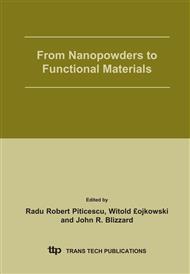p.47
p.57
p.63
p.75
p.79
p.83
p.87
p.93
p.103
New Nano-Sized Sensing Drug and Its Clinical Application
Abstract:
Nanomedicine is the application of nanotechnology to the diagnosis and treatment of human disease. This discipline has the potential to change medical science dramatically, for example as demonstrated by an innovation in cancer imaging that uses novel diagnostic agents synthesized from nanoparticles. Some research on cluster-based materials for future medical applications is described in this paper. The design of a multifunctional photosensitive particle that is stable and highly efficient will be key to this novel medical application and especially in photodynamic treatment (PDT). Three consecutive processes occur during the PDT treatment: initial consumption of oxygen through the photodynamic process; pathophysiologic alterations in regional blood supply (hypoxia) and total vascular occlusion (ischemia). The effect of a new drug TiO2/TSPP was studied work. Cancer cells were implanted under the skin of mice to cause tumors. When the size of the tumor grew to about 0.5 cm, it was injected a solution containing fine particles of TiO2/TSPP. After 2 or 3 days, the skin was cut to expose the tumor and irradiated. The treatment clearly inhibited the tumor growth. A further marked antineoplastic effect was obtained.
Info:
Periodical:
Pages:
79-82
Citation:
Online since:
September 2005
Authors:
Price:
Сopyright:
© 2005 Trans Tech Publications Ltd. All Rights Reserved
Share:
Citation:


